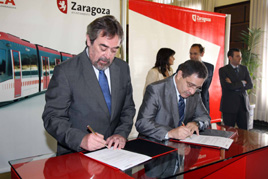Work on the Zaragoza tram to start on 18 August
The city council has approved the management model deployed through the creation of TRAZA, a partially government-owned company that will manage the construction, operation and maintenance of Zaragoza tram line 1

Zaragoza Mayor Juan Alberto Belloch has signed with TRAZA’s chairman, Luis Terradillos, to create TRAZA, a company partially owned by the government and featuring a consortium made up of CAF, TUZSA, FCC, Acciona, Ibercaja and Concessia. This temporary joint venture will hold an 80% interest in the company. The Regional Government of Aragón and the Zaragoza City Government will be the owners of the remaining 20%.
The tram line will run between the end points of Parque Goya and Valdespartera. It will be a total of 12.8 kilometres long and will have 25 stops. Trams will take a total of 40 minutes to cover the route from end to end. The first phase is expected to be operational in 2011, followed by the second in 2013.
The project involves an initial investment of approximately 340 million euro, 130 million of which will be furnished by the Zaragoza City Government and the Regional Government of Aragón in equal shares. When the job is complete, the city will be equipped with the most modern tram in all of Spain.
Work is scheduled to begin on 18 August, consisting in the construction of a separate railway bed on ground level for twin electrified tracks crossing the city of Zaragoza from north to south.
There are two consecutive phases of work:
• Phase 1 (Valdespartera to Gran Vía)
• Phase 2 (Gran Vía to Parque Goya)
In addition, the project calls for the construction of two shed and shop areas, one for each phase, plus two car parks and an intermodal transfer facility. The contract includes the supply of rolling stock plus all equipment.
The bid features CAF’s URBOS III-model trams, which will be made at the CAF plant in Zaragoza. These vehicles are 33 metres long (and can be lengthened to 43 metres) and 2.65 metres wide. Each combination is able to accommodate 200 passengers, including 54 seated passengers. These trams have a special low floor, giving people with reduced mobility full access. The maximum speed will be set at 50 kilometres per hour, although the vehicles’ commercial speed (average speed including stops) will be 19 kilometres per hour.
As established in the specifications, the central portion of the tram route, between Gran Vía and Puente de Santiago, will not be equipped with a catenary. To comply with this requirement, the TRAZA bid includes the ACR fast-charging battery system, which allows trams to accumulate enough energy at each stop to reach the next stop. In addition, these trams will recover energy when braking, which means they will save up to 35% of the power they need to operate.
When the entire line is operational, it is anticipated that it will be used by some 100,000 passengers per day, which means over 30 million users per year. Trams will pass every five minutes at rush hour, and the average fare on which the study is based is 0.75 euro.
Picture copyright: Félix Bernad








